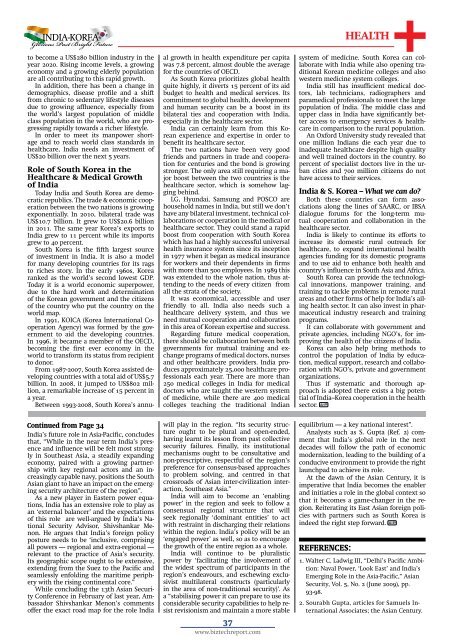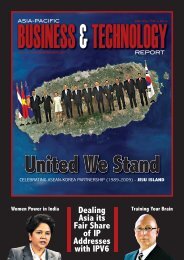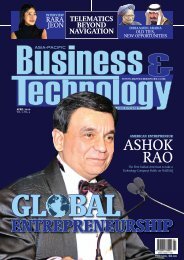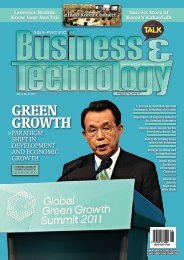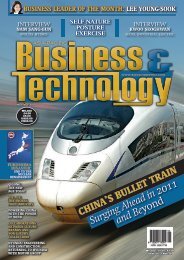INDIA-KOREA - Asia-Pacific Business and Technology Report
INDIA-KOREA - Asia-Pacific Business and Technology Report
INDIA-KOREA - Asia-Pacific Business and Technology Report
You also want an ePaper? Increase the reach of your titles
YUMPU automatically turns print PDFs into web optimized ePapers that Google loves.
<strong>INDIA</strong>-<strong>KOREA</strong><br />
Glorious Past Bright Future<br />
to become a US$280 billion industry in the<br />
year 2020. Rising income levels, a growing<br />
economy <strong>and</strong> a growing elderly population<br />
are all contributing to this rapid growth.<br />
In addition, there has been a change in<br />
demographics, disease profile <strong>and</strong> a shift<br />
from chronic to sedentary lifestyle diseases<br />
due to growing affluence, especially from<br />
the world’s largest population of middle<br />
class population in the world, who are progressing<br />
rapidly towards a richer lifestyle.<br />
In order to meet its manpower shortage<br />
<strong>and</strong> to reach world class st<strong>and</strong>ards in<br />
healthcare, India needs an investment of<br />
US$20 billion over the next 5 years.<br />
Role of South Korea in the<br />
Healthcare & Medical Growth<br />
of India<br />
Today India <strong>and</strong> South Korea are democratic<br />
republics. The trade & economic cooperation<br />
between the two nations is growing<br />
exponentially. In 2010, bilateral trade was<br />
US$10.7 billion. It grew to US$20.6 billion<br />
in 2011. The same year Korea’s exports to<br />
India grew to 11 percent while its imports<br />
grew to 40 percent.<br />
South Korea is the fifth largest source<br />
of investment in India. It is also a model<br />
for many developing countries for its rags<br />
to riches story. In the early 1960s, Korea<br />
ranked as the world’s second lowest GDP.<br />
Today it is a world economic superpower,<br />
due to the hard work <strong>and</strong> determination<br />
of the Korean government <strong>and</strong> the citizens<br />
of the country who put the country on the<br />
world map.<br />
In 1991, KOICA (Korea International Cooperation<br />
Agency) was formed by the government<br />
to aid the developing countries.<br />
In 1996, it became a member of the OECD,<br />
becoming the first ever economy in the<br />
world to transform its status from recipient<br />
to donor.<br />
From 1987-2007, South Korea assisted developing<br />
countries with a total aid of US$5.7<br />
billion. In 2008, it jumped to US$802 million,<br />
a remarkable increase of 15 percent in<br />
a year.<br />
Between 1993-2008, South Korea’s annual<br />
growth in health expenditure per capita<br />
was 7.8 percent, almost double the average<br />
for the countries of OECD.<br />
As South Korea prioritizes global health<br />
quite highly, it diverts 15 percent of its aid<br />
budget to health <strong>and</strong> medical services. Its<br />
commitment to global health, development<br />
<strong>and</strong> human security can be a boost in its<br />
bilateral ties <strong>and</strong> cooperation with India,<br />
especially in the healthcare sector.<br />
India can certainly learn from this Korean<br />
experience <strong>and</strong> expertise in order to<br />
benefit its healthcare sector.<br />
The two nations have been very good<br />
friends <strong>and</strong> partners in trade <strong>and</strong> cooperation<br />
for centuries <strong>and</strong> the bond is growing<br />
stronger. The only area still requiring a major<br />
boost between the two countries is the<br />
healthcare sector, which is somehow lagging<br />
behind.<br />
LG, Hyundai, Samsung <strong>and</strong> POSCO are<br />
household names in India, but still we don’t<br />
have any bilateral investment, technical collaborations<br />
or cooperation in the medical or<br />
healthcare sector. They could st<strong>and</strong> a rapid<br />
boost from cooperation with South Korea<br />
which has had a highly successful universal<br />
health insurance system since its inception<br />
in 1977 when it began as medical insurance<br />
for workers <strong>and</strong> their dependents in firms<br />
with more than 500 employees. In 1989 this<br />
was extended to the whole nation, thus attending<br />
to the needs of every citizen from<br />
all the strata of the society.<br />
It was economical, accessible <strong>and</strong> user<br />
friendly to all. India also needs such a<br />
healthcare delivery system, <strong>and</strong> thus we<br />
need mutual cooperation <strong>and</strong> collaboration<br />
in this area of Korean expertise <strong>and</strong> success.<br />
Regarding future medical cooperation,<br />
there should be collaboration between both<br />
governments for mutual training <strong>and</strong> exchange<br />
programs of medical doctors, nurses<br />
<strong>and</strong> other healthcare providers. India produces<br />
approximately 25,000 healthcare professionals<br />
each year. There are more than<br />
250 medical colleges in India for medical<br />
doctors who are taught the western system<br />
of medicine, while there are 400 medical<br />
colleges teaching the traditional Indian<br />
health<br />
system of medicine. South Korea can collaborate<br />
with India while also opening traditional<br />
Korean medicine colleges <strong>and</strong> also<br />
western medicine system colleges.<br />
India still has insufficient medical doctors,<br />
lab technicians, radiographers <strong>and</strong><br />
paramedical professionals to meet the large<br />
population of India. The middle class <strong>and</strong><br />
upper class in India have significantly better<br />
access to emergency services & healthcare<br />
in comparison to the rural population.<br />
An Oxford University study revealed that<br />
one million Indians die each year due to<br />
inadequate healthcare despite high quality<br />
<strong>and</strong> well trained doctors in the country. 80<br />
percent of specialist doctors live in the urban<br />
cities <strong>and</strong> 700 million citizens do not<br />
have access to their services.<br />
India & S. Korea – What we can do?<br />
Both these countries can form associations<br />
along the lines of SAARC, or IBSA<br />
dialogue forums for the long-term mutual<br />
cooperation <strong>and</strong> collaboration in the<br />
healthcare sector.<br />
India is likely to continue its efforts to<br />
increase its domestic rural outreach for<br />
healthcare, to exp<strong>and</strong> international health<br />
agencies funding for its domestic programs<br />
<strong>and</strong> to use aid to enhance both health <strong>and</strong><br />
country’s influence in South <strong>Asia</strong> <strong>and</strong> Africa.<br />
South Korea can provide the technological<br />
innovations, manpower training, <strong>and</strong><br />
training to tackle problems in remote rural<br />
areas <strong>and</strong> other forms of help for India’s ailing<br />
health sector. It can also invest in pharmaceutical<br />
industry research <strong>and</strong> training<br />
programs.<br />
It can collaborate with government <strong>and</strong><br />
private agencies, including NGO’s, for improving<br />
the health of the citizens of India.<br />
Korea can also help bring methods to<br />
control the population of India by education,<br />
medical support, research <strong>and</strong> collaboration<br />
with NGO’s, private <strong>and</strong> government<br />
organizations.<br />
Thus if systematic <strong>and</strong> thorough approach<br />
is adopted there exists a big potential<br />
of India–Korea cooperation in the health<br />
sector. A-P<br />
Continued from Page 34<br />
India’s future role in <strong>Asia</strong>-<strong>Pacific</strong>, concludes<br />
that, “While in the near term India’s presence<br />
<strong>and</strong> influence will be felt most strongly<br />
in Southeast <strong>Asia</strong>, a steadily exp<strong>and</strong>ing<br />
economy, paired with a growing partnership<br />
with key regional actors <strong>and</strong> an increasingly<br />
capable navy, positions the South<br />
<strong>Asia</strong>n giant to have an impact on the emerging<br />
security architecture of the region”.<br />
As a new player in Eastern power equations,<br />
India has an extensive role to play as<br />
an ‘external balancer’ <strong>and</strong> the expectations<br />
of this role are well-argued by India’s National<br />
Security Advisor, Shivshankar Menon.<br />
He argues that India’s foreign policy<br />
posture needs to be ‘inclusive, comprising<br />
all powers — regional <strong>and</strong> extra-regional —<br />
relevant to the practice of <strong>Asia</strong>’s security.<br />
Its geographic scope ought to be extensive,<br />
extending from the Suez to the <strong>Pacific</strong> <strong>and</strong><br />
seamlessly enfolding the maritime periphery<br />
with the rising continental core.”<br />
While concluding the 13th <strong>Asia</strong>n Security<br />
Conference in February of last year, Ambassador<br />
Shivshankar Menon’s comments<br />
offer the exact road map for the role India<br />
will play in the region. “Its security structure<br />
ought to be plural <strong>and</strong> open-ended,<br />
having learnt its lesson from past collective<br />
security failures. Finally, its institutional<br />
mechanisms ought to be consultative <strong>and</strong><br />
non-prescriptive, respectful of the region’s<br />
preference for consensus-based approaches<br />
to problem solving, <strong>and</strong> centred in that<br />
crossroads of <strong>Asia</strong>n inter-civilization interaction,<br />
Southeast <strong>Asia</strong>.”<br />
India will aim to become an ‘enabling<br />
power’ in the region <strong>and</strong> seek to follow a<br />
consensual regional structure that will<br />
seek regionally ‘dominant entities’ to act<br />
with restraint in discharging their relations<br />
within the region. India’s policy will be an<br />
‘engaged power’ as well, so as to encourage<br />
the growth of the entire region as a whole.<br />
India will continue to be pluralistic<br />
power by ‘facilitating the involvement of<br />
the widest spectrum of participants in the<br />
region’s endeavours, <strong>and</strong> eschewing exclusivist<br />
multilateral constructs (particularly<br />
in the area of non-traditional security)’. As<br />
a “stabilising power it can prepare to use its<br />
considerable security capabilities to help resist<br />
revisionism <strong>and</strong> maintain a more stable<br />
37<br />
www.biztechreport.com<br />
equilibrium — a key national interest”.<br />
Analysts such as S. Gupta (Ref. 2) comment<br />
that India’s global role in the next<br />
decades will follow the path of economic<br />
modernization, leading to the building of a<br />
conducive environment to provide the right<br />
launchpad to achieve its role.<br />
At the dawn of the <strong>Asia</strong>n Century, it is<br />
imperative that India becomes the enabler<br />
<strong>and</strong> initiaties a role in the global context so<br />
that it becomes a game-changer in the region.<br />
Reiterating its East <strong>Asia</strong>n foreign policies<br />
with partners such as South Korea is<br />
indeed the right step forward. A-P<br />
References:<br />
1. Walter C. Ladwig III, “Delhi’s <strong>Pacific</strong> Ambition:<br />
Naval Power, ‘Look East’ <strong>and</strong> India’s<br />
Emerging Role in the <strong>Asia</strong>-<strong>Pacific</strong>,” <strong>Asia</strong>n<br />
Security, Vol. 5, No. 2 (June 2009), pp.<br />
93-98.<br />
2. Sourabh Gupta, articles for Samuels International<br />
Associates; the <strong>Asia</strong>n Century.


